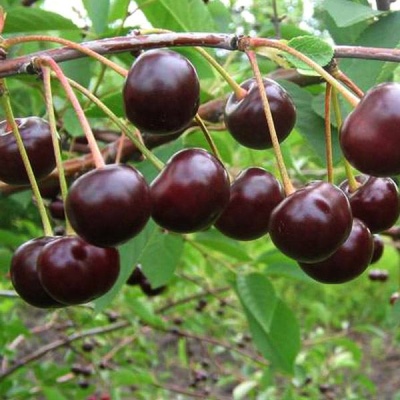
- Barrel type: wood
- Growth type: medium-sized
- Crown: wide, spreading, not very thick
- Fruit size: large
- Fruit shape: rounded
- Fruit color: dark red, almost brown
- Fruit weight, g: up to 5
- Pulp color : Dark red
- Pulp (consistency): dense, juicy
- Separability of the bone from the pulp: good
Cherries are a wonderful culture that is easy to care for. Currently, there is a wide variety of varieties that are not similar to each other in their taste and characteristics. But there is one type of cherry that is especially popular with gardeners. This is Zagorievskaya cherry.
Breeding history
The variety was bred in Biryulevo at the Technological Institute of Horticulture and Nursery. Previously, the village of Zagorje was located in this place (it was in honor of the village that the cultured culture was named). Cherries Lyubskaya and Consumer goods black were chosen for the parental pair.
The originators specially created the Zagorievskaya cherry with such characteristics that it would take root well and bear fruit well in the northwestern part of Russia and in regions with small temperature differences.
Description of the variety
According to the type of growth, the Zagorievskaya cherry belongs to medium-sized and reaches a height of 3 m. It looks like an ordinary cherry. The crown is not too dense, but wide and spreading. Often, without forming, the crown takes on a rounded shape.
Due to the fact that the skeletal branches are not in close proximity to each other, and there is a significant gap between them, this ensures the safety of the tree and reduces the risk of fungal diseases.
The bark of the tree is cherry brown. Young shoots bend well (they are greenish-brown in color). But more mature branches can bend and break under the weight.
Leaves are standard, oblong, matte. The veins are very strongly visible on the back surface. There is a scalloped border around the edges.
Flowering occurs at the end of May. The buds are cup-shaped, white. The number of leaves in a bud is 4-5. The aroma is sweet, therefore it actively attracts bees and other insects.
The Zagorievskaya cherry has excellent winter hardiness and drought tolerance. The yield does not drop from season to season, and the small size of the tree makes harvesting easier.
But even such a wonderful variety has disadvantages. Basically, this is that the fruit has a slightly sour aftertaste. With improper care, the culture can become infected with a fungus, the immunity of cherries is not so strong. It is also noted that during spring frosts, the buds may freeze. Therefore, gardeners are advised to cover the crown.
Fruit characteristics
The berry is very large, round in shape, weighing from 3 to 5 g. There are also more weighty fruits, but they are usually single.
Outwardly, Zagorievskaya cherry is easy to confuse with sweet cherry. The cherry skin is rather smooth, gives off a gloss in the sun. The peel has a maroon or dark scarlet color with an admixture of brown.
The pulp is dense, juicy and very tender, dark red in color. Inside there is a small bone that can be easily separated from the berry.
The fruits are formed on an elongated peduncle. They are well adhered to each other, therefore, when harvesting, it is necessary to make some effort to tear the berry from the stalk.The separation point is semi-dry.
Culture has a universal purpose. Compotes, jams, preserves are prepared from cherries, and they are also frozen, while the fruits do not lose their taste.
Taste qualities
For some, cherries have a fruity, sparkling flavor. Someone notes a short sour aftertaste. But the characteristics indicate a rather high tasting score, which is 4.5 points. Therefore, the variety belongs to dessert.
Ripening and fruiting
The first harvest falls on 3-4 years after planting the crop in open ground. Flowering occurs in May and lasts from 2 to 2.5 weeks.
In terms of ripening, the variety belongs to medium early crops. Fruiting begins in mid-July, and the harvest is carried out in several stages.

Yield
Gardeners note that Zagorievskaya cherries have very high yield rates. An adult tree is capable of producing an average of 11 to 13 kg of berries per season. And in the most prolific years, the yield can rise to 15-16 kg. Young trees in the first years of fruiting give from 3 to 5 kg of fruit, gradually increasing the yield every season.
Self-fertility and the need for pollinators
The originators stated that the variety is self-fertile. Therefore, the culture does not require additional pollination.
Landing
Cherries love neutral soil, and it is best to choose a sunny and slightly hilly place for planting (excess moisture can adversely affect the roots).
You can plant seedlings in autumn and spring. In cold regions, it is recommended to postpone this procedure in the spring, so that the roots can germinate well in the non-frozen ground.
A pit of 0.5x1 m is prepared in advance.The depth may increase depending on the size of the root system and the age of the seedling.
The excavated soil is best mixed with fertilizers to saturate the cherries with beneficial minerals.
And also it is necessary to prepare a peg for the sapling garter.
The tree is carefully lowered into the hole, straightening all the roots and avoiding creases. After that they fall asleep with earth, tamping.
After planting, the soil around the trunk is spilled with 2 buckets of water. Cherries are tied to a peg, and the dried soil is covered with mulch.


Growing and caring
Plant care consists in:
regular watering;
top dressing;
pruning;
preparing for winter.


































































